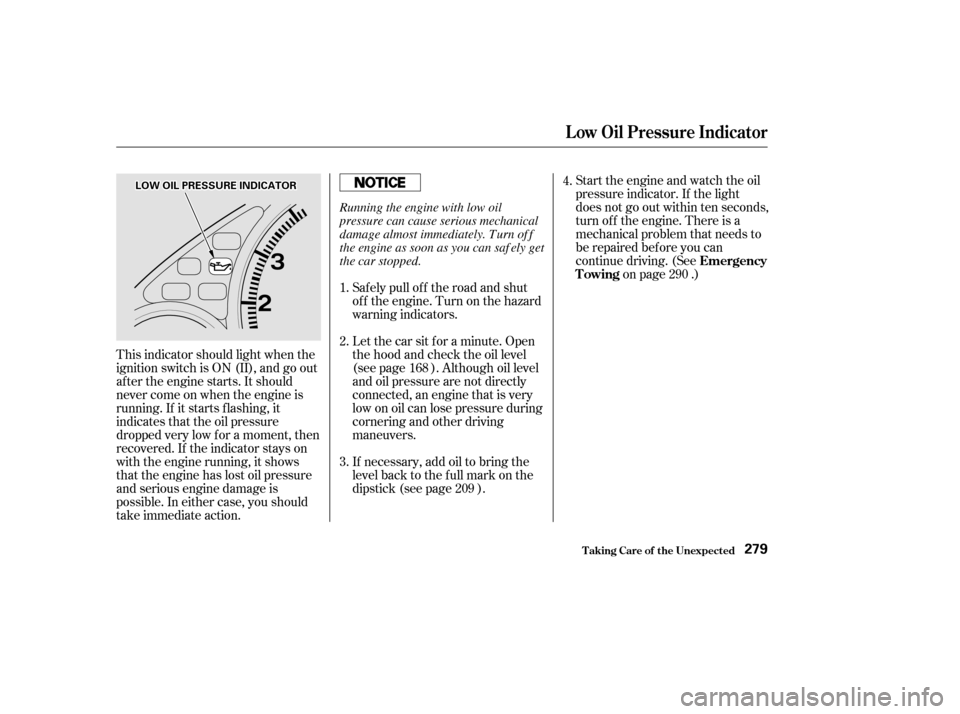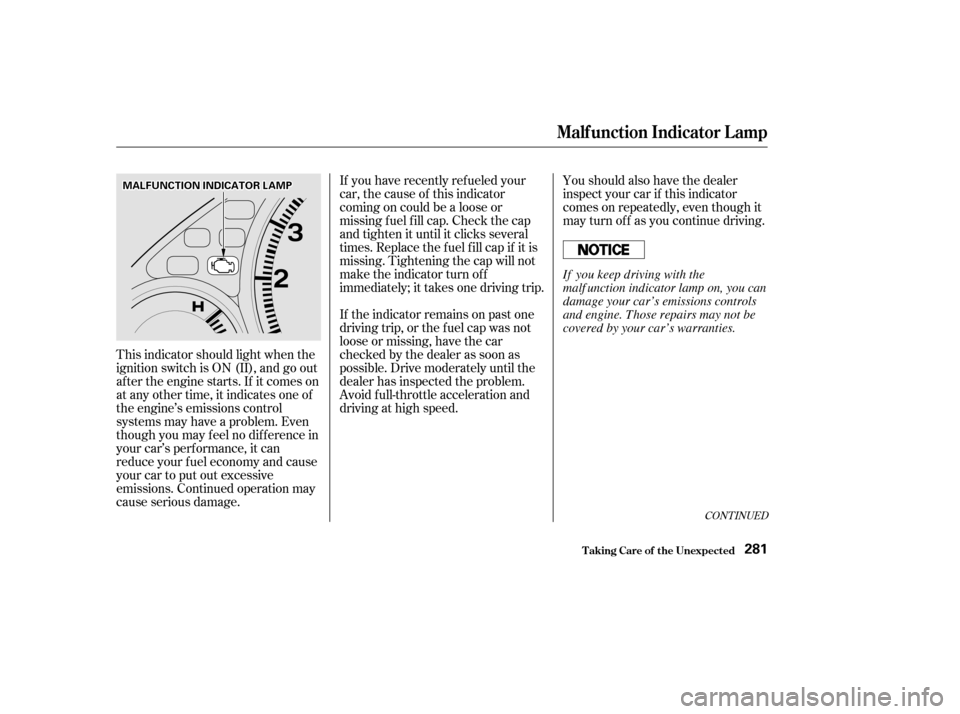Page 278 of 321

This indicator should light when the
ignition switch is ON (II), and go out
af ter the engine starts. It should
never come on when the engine is
running. If it starts f lashing, it
indicates that the oil pressure
dropped very low f or a moment, then
recovered. If the indicator stays on
with the engine running, it shows
that the engine has lost oil pressure
and serious engine damage is
possible. In either case, you should
take immediate action.Saf ely pull of f the road and shut
of f the engine. Turn on the hazard
warning indicators.
If necessary, add oil to bring the
level back to the full mark on the
dipstick (see page ).
Letthecarsitforaminute.Open
the hood and check the oil level
(see page ). Although oil level
and oil pressure are not directly
connected, an engine that is very
low on oil can lose pressure during
cornering and other driving
maneuvers. Start the engine and watch the oil
pressure indicator. If the light
does not go out within ten seconds,
turn of f the engine. There is a
mechanical problem that needs to
be repaired bef ore you can
continue driving. (See
on page .)
1. 2. 3. 4.
168 209 290
L ow Oil Pressure Indicator
T aking Care of t he Unexpect ed
Emergency
Towing
279
LLOOWWOOIILLPPRREESSSSUURREEIINNDDIICCAATTOORR
Running the engine with low oil
pressure can cause serious mechanical
damage almost immediately. Turn of f
the engine as soon as you can saf ely get
the car stopped.
Page 280 of 321

If you have recently ref ueled your
car, the cause of this indicator
coming on could be a loose or
missing f uel f ill cap. Check the cap
and tighten it until it clicks several
times. Replace the f uel f ill cap if it is
missing. Tightening the cap will not
make the indicator turn of f
immediately; it takes one driving trip.
If the indicator remains on past one
driving trip, or the f uel cap was not
loose or missing, have the car
checked by the dealer as soon as
possible. Drive moderately until the
dealer has inspected the problem.
Avoid full-throttle acceleration and
driving at high speed.Youshouldalsohavethedealer
inspect your car if this indicator
comes on repeatedly, even though it
may turn of f as you continue driving.
This indicator should light when the
ignition switch is ON (II), and go out
af ter the engine starts. If it comes on
at any other time, it indicates one of
the engine’s emissions control
systems may have a problem. Even
though you may f eel no dif f erence in
your car’s perf ormance, it can
reduce your f uel economy and cause
your car to put out excessive
emissions. Continued operation may
cause serious damage.
CONT INUED
T aking Care of t he Unexpect ed
Malf unct ion Indicat or L amp
281
MMAALLFFUUNNCCTTIIOONNIINNDDIICCAATTOORRLLAAMMPP
If you keep driving with the
malf unction indicator lamp on, you can
damage your car’s emissions controls
and engine. Those repairs may not be
covered by your car’s warranties.
Page 282 of 321

�Î�Î
�Î�ÎSlow down by shif ting to a lower
gear, and pull to the side of the road
when it is saf e. Because of the
longer distance needed to stop, it is
hazardous to drive the car. You
should have it towed, and repaired as
soon as possible. (Seeon page .)
If you must drive the car a short
distance in this condition, drive
slowly and cautiously.
If it comes on at any other time, it
indicates a problem with the car’s
brake system. In most cases, the
problem is a low f luid level in the
brake f luid reservoir. Press lightly on
the brake pedal to see if it f eels
normal. If it does, check the brake
f luid level the next time you stop at a
service station (see page ). If the
fluid level is low, take the car to your
dealer and have the brake system
inspected f or leaks or worn brake
pads.
However, if the brake pedal does not
f eel normal, you should take
immediate action. Because of the
brake system’s dual-circuit design, a
problem in one part of the system
will still give you braking at two
wheels. You will f eel the brake pedal
go down much f arther bef ore the car
begins to slow down, and you will
have to press harder on the pedal.
The distance needed to stop will be
much longer.
The Brake System Indicator
normallycomesonwhenyouturn
the ignition switch ON (II). It is a
reminder to check the parking brake.
It comes on and stays lit if you do not
f ully release the parking brake.
222
290Emergency
Towing
Brake System Indicator
T aking Care of t he Unexpect ed283
UU..SS..iinnddiiccaattoorrsshhoowwnn
BBRRAAKKEESSYYSSTTEEMMIINNDDIICCAATTOORR
Page 285 of 321

If something electrical in your car
stops working, the f irst thing you
should check f or is a blown f use.
Determine f rom the chart on pagesand , or the diagram on the
fuse box lid, which fuse or fuses
control that component. Check those
f uses f irst, but check all the f uses
bef ore deciding that a blown f use is
not the cause. Replace any blown
f uses and check the component’s
operation.
Turn the ignition switch to LOCK
(0). Make sure the headlights and
all other accessories are off.
Remove the cover f rom the f use
box. Check each of the large f uses in
the under-hood f use box by
looking through the top at the wire
inside. Removing these f uses
requires a Phillips-head screw-
driver.
Check the smaller f uses in the
under-hood f use box and all the
fuses in the interior fuse box by
pulling out each f use with the f use
puller provided in the under-hood
fuse box.
3.
1. 2. 4.
288 289
Checking and Replacing Fuses
Fuses
T aking Care of t he Unexpect ed286
FFUUSSEE
BBLLOOWWNN
FFUUSSEEPPUULLLLEERR
Page 287 of 321
�µ
�µ
�µ
No. Amps. Circuits Protected
1 23456789
1011121314151617181920 20 A
15 A
7.5 A 20 A
10 A
15 A
15 A
20 A
10 A
40 A
30 A
40 A
40 A
40 A
15 A
20 A
15 A
80 A
40 A Condenser Fan
Small Light
Interior Light
Cooling Fan
Hazard
FI ECU
Horn, Stop
ABS F/S
Back Up
ABS Motor
Rear Defroster
Heater Motor
Power Window
Option
Lef t Headlight
Door Lock
Right Headlight
Not Used
Battery
Ignition 1
Spare Fuses
21 257.5A 30A
T aking Care of t he Unexpect ed
Fuses
288
UNDER-HOOD FUSE BOX
Page 288 of 321
�µ�µ �µ �µ �µ
�Î
�Î
�Î
No. Amps. Circuits ProtectedNo. Amps. Circuits Protected
: On Canadian models
1 2345 15 A
20 A
10 A
10 A
Ignition Coil
LAF Heater
Daytime running lights
Alternator
Not Used 6789
10111213141516171819202122232425 7.5 A
20 A
7.5 A
7.5 A
7.5 A
7.5 A 10 A
10 A
15 A
15 A
7.5 A 20 A
20 A
20 A
20 A
20 A Power Window Relay
Moonroof
Accessory, Radio
Not Used
Meter
ABS
Daytime running lights
SRS
Remote Control Mirrors
Not Used
Not Used
Fuel Pump
Accessory Power Socket
Turn Signal Lights
Front Wiper
Not Used
Front Right Power Window
Front Left Power Window
Rear Lef t Power Window
Rear Right Power Window
Fuses
T aking Care of t he Unexpect ed289
INTERIOR FUSE BOX
Page 296 of 321

�µ�µ�µ
�Î �Î �µ�µ �µ �µ�µ �µ �µ�µ�µ�µ�µ�µ�µ�µ �µ
�Î �Î�Î�Î
�Î �Î
�Î
�Î�Î
�Î�Î
Specif ications
T echnical Inf ormation297
Battery Fuses
Tires
Alignment
Lights
Air Conditioning
HFC-134a (R-134a)
17.6 19.4 oz (500 550 g)
SP-10
12 V
12 V 60/55 W (HB2)
21/5 W
60 psi (420 kPa , 4.2 kgf/cm
)
12 V 5 W
12 V 8 W
12 V 5 W
12 V 5 W
12 V 8 W
12 V 3 CP
12 V 21 W
12 V 3 CP
12 V 21 W
12 V 21/5 W
12 V 21 W
12 V 3 CP
12 V 36 AH/5 HR
Capacity Interior
Under-hood Size
Pressure
Toe-in
Camber
Caster
1°33’0°50’
0°
0.00 in (0.0 mm)
30 psi (210 kPa , 2.1 kgf/cm)
T115/70D14 88M
P185/65R15 86HP185/70R14 87S
Headlights (HI/LO)
Front turn signal/side marker
lights
Front parking light
Rear turn signal lights
Stop/Taillights/Rear side
marker lights
Back-up lights
Taillights
High-mount brake light
License plate lights
Ceiling light
Front ceiling light
Spotlights
Trunk light
Refrigerant type
Charge quantity
Lubricant oil type
0.08 in (2.0 mm)
T125/70D15 95M
See page 289 or the fuse label
attached to the inside of the fuse
box door under the steering
column.
See page 288 or the fuse box
cover.
FrontRear
FrontRear
Front
1: EX
2: LX Front/Rear
Spare
Front/Rear
Spare
1 : US: DX, LX Canada: DX
2: US:EX Canada: LX
3 : US: DX, LX without ABS Canada: DX
4 : US: EX, LX with ABS Canada: LX
12
1
34
12
Page 301 of 321

�Î�ÎIn Canada, Honda vehicles comply
with the Canadian Motor Vehicle
Saf ety Standards (CMVSS) f or
Emissions valid at the time they are
manuf actured.
The United States Clean Air Act
sets standards f or automobile
emissions. It also requires that
automobile manufacturers explain to
owners how their emissions controls
workandwhattodotomaintain
them. This section summarizes how
the emissions controls work.
Scheduled maintenance is on page
.
The burning of gasoline in your car’s
engine produces several byproducts.
Some of these are carbon monoxide
(CO), oxides of nitrogen (NOx) and
hydrocarbons (HC). Gasoline
evaporating from the tank also
produces hydrocarbons. Controlling
the production of NOx, CO, and HC
is important to the environment.
Under certain conditions of sunlight
and climate, NOx and HC react to
f orm photochemical ‘‘smog.’’ Carbon
monoxide does not contribute to
smog creation, but it is a poisonous
gas.
Your car has a Positive Crankcase
Ventilation System. This keeps
gasses that build up in the engine’s
crankcase from going into the
atmosphere. The Positive Crankcase
Ventilation valve routes them fromthe crankcase back to the intake
manif old. They are then drawn into
the engine and burned.
As gasoline evaporates in the f uel
tank, an evaporative emissions
control canister f illed with charcoal
adsorbs the vapor. It is stored in this
canister while the engine is of f . Af ter
the engine is started and warmed up,
the vapor is drawn into the engine
and burned during driving.
The Onboard Ref ueling Vapor
Recovery (ORVR) system captures
the f uel vapors during ref ueling. The
vapors are adsorbed in a canister
f illed with activated carbon. While
driving, the f uel vapors are drawn
into the engine and burned of f .
200
The Clean Air Act
Crankcase Emissions Control
System Evaporative Emissions Control
System
Onboard Ref ueling Vapor
Recovery
T echnical Inf ormation
Emissions Cont rols
302